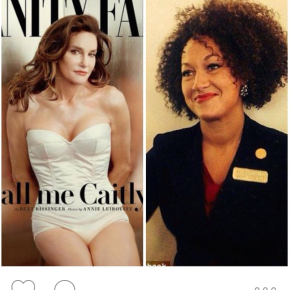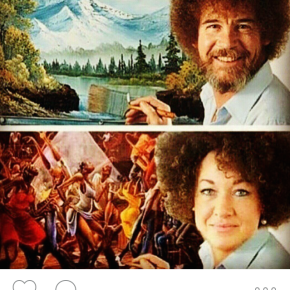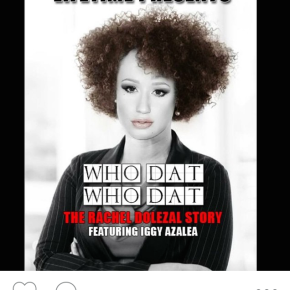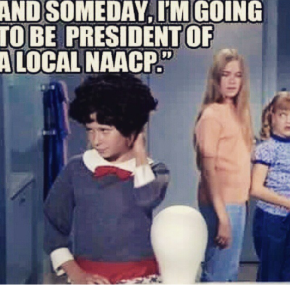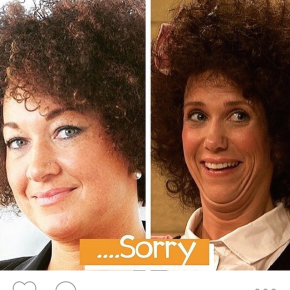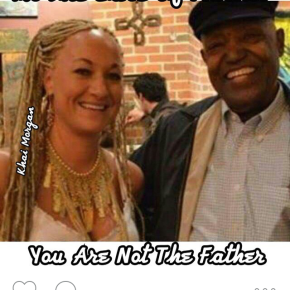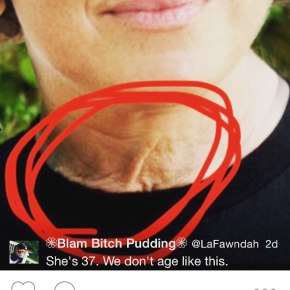
Rachel Dolezal, Blackness from the Italian Renaissance taken in Venice, Italy (2015), A Ghanain sign promoting hairstyles, Photomontage by Katy Hamer
A rain storm just waiting to occur, the media has flooded with stories on now former National Association for the Advancement of Colored People (NAACP) President of the Spokane, Washington chapter, Rachel Dolezal. Dolezal was recently ‘outed’ by her biological parents, to be someone who is living life as a black woman when in fact she is caucasian. Immediately, the Internet awoke with articles, photographs from her former (formative) years, stories, and a recorded thesis project by a student at the university where Dolezal is a part-time professor of African studies, specifically questioning her on issues of being a ‘mixed’ race and identifying as a black woman. Responses have been mixed and a hashtag, #askrachel, popped up on both Instagram and Twitter platforms, comically offering scenarios that presumably could only be answered by someone who was born black. The public has wondered if mental illness is involved, unadulterated deceit, identity delusions, falsifying truth to gain career accolades. Containing many intricate levels, the story arrives on the heels of the recent transition of Caitlyn Jenner and a controversial opinion piece from the New York Times by Elinor Burkett (What Makes a Woman?, June 6th, 2015) whereas the author criticises Jenner for her over-feminized appearance in relationship to feminism and the struggle that women have fought to not please their male counterparts. Just one week prior to Rachel Dolezal’s unexpected reveal, Burkett stated,
“The “I was born in the wrong body” rhetoric favored by other trans people doesn’t work any better and is just as offensive, reducing us to our collective breasts and vaginas. Imagine the reaction if a young white man suddenly declared that he was trapped in the wrong body and, after using chemicals to change his skin pigmentation and crocheting his hair into twists, expected to be embraced by the black community.”
The statement is harsh and critical of the personal and mental confusion that many trans people feel around gender identity. In its comparison to what is now being referred to as transracial the quote was made without prior knowledge of Rachel Dolezal and the fact that she had in fact darkened her skin and permed her naturally straight hair, even at times wearing a weave to fit a traditionally black aesthetic. Is it possible that while some people are born feeling as if their gender assigned at birth has never met the gender they feel internally, that someone could feel the race they were born into, is not the race they actually identify as? I actually think so. Whether or not it is the case with Dolezal, has yet to be determined, but based on past interviews and statements she has made, her personal situation and story seems to be flawed and inconsistent. However, as issues of self-identification arise and questions of a post-gender society seem possible, can we ever imagine being post-race? This issue is specifically challenging in the United States where the initial entrance of blacks to the Americas was via the slave trade. Slaves did not have a choice and were taken from their families and homes to a strange and unfamiliar landscape for the purpose of others. As the Holocaust has affected the Jewish experience, so has this gravely affected the black experience particularly in the face of power dynamics, equality and integration. Just in the past year we have witnessed the killing of several unarmed black men by police officers and the rallying cry over social media: #blacklivesmatter
Differentiation in skin pigmentation varies consistently around race, on every continent. There are varying shades of flesh that are categorized as white, black. Each and every continent, nationality and in some cases even religion, brings forth a particular discernible characteristic that leads to identification, designation and at times stereotyping. Beyond the visual recognition of skin tone, is the experience tacked on to the association that one has with a particular pigment variation. For this particular article and in the case of Rachel Dolezal, we will refer to the white experience and the black experience. While one could argue that they are irreconcilably different, however experience −familial, socio-economic, environmental, historical−can also overlap, specifically in a contemporary society. Race, and all of the complications associated with it, is complicated.
Just as Jenner finally emerged as Caitlyn, a truer, more honest form of self, Dolezal on the Today Show with Matt Lauer declared, “I identify as black.” Can the two be compared? They both carry a significant amount of psychological weight and controversy. In both situations neither breasts nor hairstyle choice leads to a particular form of womanhood. True identity comes from a a place deep within the self and the issues arise based on what other people see. As a whole, we might be in one of the most interesting moments of a long historical timeline: when the internal self merges with the external self and in some cases with a level of public approval.
All this being said, Dolezal’s declaration is flawed as it was only the result of her being ‘outted’. It feels performative −specifically around her didactic and empathetic approach to teaching in the Africana Studies department of Eastern Washington University as revealed in a series of videos student Lauren Campbell made as part of her thesis project at the university. The videos include a dialogue between the two women in both candid and oddly removed way. Dolezal’s choice of language skates around identity verbiage almost as if she was aware of the fallacy in her form of truth.
Growing up a caucasian female in a single-parent household with socio-economic struggles, I never felt a strong connection to femininity or necessarily to whiteness. As a child I was often mistaken for a the male gender. This caused me great stress as I didn’t understand why I looked different from the other girls, it feeling both as a choice and an obligation to appear a certain way. The neighborhood where I grew up was fairly diverse ethnically and has since become much more. Yet it was still dominated by white sections and black sections. As a child I would often go on extended bike rides into the nearby, predominantly black area (where they did have the best hills) and through spirit of inquiry and what could only be described as s sense of longing for a community, knowing that if my skin didn’t burn so quickly in the sun, I’d fit in, or so I thought at 12 years old. There is a mysticism in the Other. From “belonging, a culture of place” (Routledge, 2009) author bell hooks states,
“Stereotypes, however inaccurate, are one form of representation. Like fictions, they are created to serve as substitutions, standing in for what is real. They are there not to tell it like it is but to invite and encourage pretense. They are a fantasy, a projection onto the Other that makes them less threatening. Stereotypes abound when there is distance. They are an invention, a pretense that one knows when the steps that would make real knowing possible cannot be taken or are not allowed.
Looking past stereotypes to consider various representations of whiteness in the black imagination, I appeal to memory, to my earliest recollections of ways these issues were raised in black life. Returning to memories of growing up in the social circumstances created by racial apartheid, to all black spaces on the edges of town, I re-inhabit a location where black folks associated whiteness with the terrible, the terrifying, the terrorizing.”
Then continuing, “Did they journey across the tracks with the same “adventurous” spirit that other white men carried to Africa, Asia, to those mysterious places they would call the ‘third world’?”
And herein lies the biggest issue regarding Dolezal and the concept of performative race, history and choice do not mix. In her interview with Lauer on the Today Show, she states that after experiencing a racially motivated hate crime she was first identified as “transracial, and then when some of the opposition to some of the human rights work I was doing came forward and started the next newspaper article referred to me as a biracial woman. And then the next article, when there were burglaries, nooses etc., [stated] that this is happening to a black woman and I never corrected that.” She fooled both the white and the black communities. While some critics have used the term ‘blackface’ what she has done instead is an extreme form of cultural appropriation. By not correcting others in the misidentification of her race, she assumed a role and a deeply rooted history, not her own. What I would bargain is that this is not the first time this has happened, the last or the most unique. But due to the particular esteem she had achieved within the black community in Spokane, seems to have added fuel to the fire of her imitation game.
Cultural appropriation has gone on for decades not in jest, or misguided deceit. This is particularly true in the music industry. Returning to my own teenage years, the only school dance I attended, not having chosen to go to the senior or junior prom, was a performance by the Young Black Teenagers, none of who were black. They had a popular song, really their only hit, in 1993 called Tap the Bottle. At the time, the band had various types of fans and claimed the name was an homage to a culture, but obviously some found it offensive. Another white musician who was both lauded and criticized for his appropriation of Jamaican-style reggae was Canadian performer, Snow and his then hit, Informer. Fast forward to current day and artists such as Katy Perry (her 2013 performance at the American Music Award’s was lambasted for the appropriation of Japanese aesthetic) to Miley Cyrus (an MTV Music Awards performance that stirred the racial pot) and Justin Bieber who have all been denounced at one time or another for cultural appropriation, musically and/or visually in reference to a the branding of their respective ‘looks’. In another text by hooks, (Black Looks: Race and Representation, South End Press, 1992) titled, Madonna, Plantation Mistress or Soul Sista, the author investigates the deeper meaning behind Madonna performance choices and video themes over the years in relationship to black culture.
In all of these instances, stylistic dynamics where most likely employed by an agency to boost the artist’s street credentials or sound, and in some cases to express their actual interests. Where the difference lies between these individuals and Rachel Dolezal is that when filling out official paperwork, she checks the Black/African-American box when self-identifying along with Native American and Caucasian for good measure. If Miley Cyrus or Madonna were to announce that they consider themselves to be trans-racial or black, I’m sure the entire commercial world would be up in arms. But then, like most hot-button issues it would trend on social media, until something seemingly more important or new garnered attention. While this story is destined to fade away into the deep chasms of reportage, it has for all intense purposes started a dialogue, even if begrudgingly, about race, identity and the possibilities of a post-racial, maybe even post-identity conversation. Keep your fingers on the pulse and stay tuned because in this case, ignorance is never bliss.
A selection of memes from Instagram, searched under the hashtag: #askrachel
- Something that has been a topic of discussion, Transgender vs. Transracial, #askrachel, Image from instagram, screenshot, 2015
- #askrachel, Image from instagram, Bob Ross vs. Rachel Dolezal, screenshot, 2015
- #askrachel, Image from instagram, screenshot, 2015
- #askrachel, Image from instagram, screenshot, 2015
- #askrachel, Image from instagram, screenshot, 2015
- #askrachel, Image from instagram, even Hillary is in on it now, screenshot, 2015
- #askrachel, Image from instagram, A little Maury Povich reference, screenshot, 2015
- #askrachel, Image from instagram, screenshot, 2015
- #askrachel, Image taken from the web, 2015

